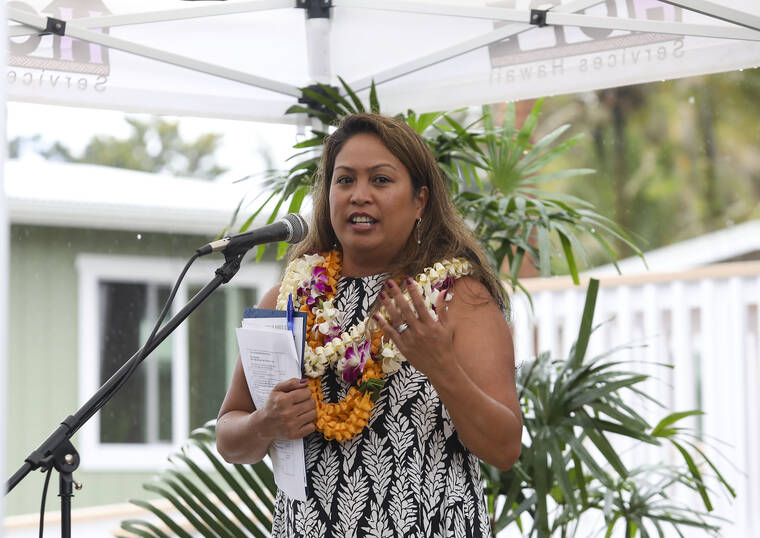By JOHN BURNETT Hawaii Tribune-Herald | Thursday, November 9, 2023, 12:05 a.m.


Kelsey Walling/Tribune-Herald — A sign welcomes visitors to one of the homes in the Sacred Heart Affordable Housing Project in Pahoa on Wednesday, Nov. 8, 2023.

Kelsey Walling/Tribune-Herald — Brandee Menino, CEO of Hope Services Hawaii, speaks Wednesday about the journey to creating the Sacred Heart Affordable Housing Project in Pahoa.

Kelsey Walling/Tribune-Herald — From left, James Koshiba, Gov. Josh Green’s state homeless coordinator, and Walter Silva, a future Sacred Heart Affordable Housing Project resident, smile as Brandee Menino, CEO of Hope Services Hawaii, talks about the project.

Kelsey Walling/Tribune-Herald — People tour the 12 homes in the Sacred Heart Affordable Housing Project on Wednesday during its official opening.

About 100 people attended the grand opening Wednesday of the Sacred Heart Affordable Housing Project in Pahoa.
The project is described by its owners and managers, Hope Services Hawaii, as a “community of 12 prefabricated modular homes and resource center, serving as affordable housing for kupuna.”
Four of the 480-square-foot homes are reserved for U.S. military veterans who are kupuna, and two of the units are equipped with wheelchair ramps. All of the double-walled studio units sit on concrete foundations, are furnished, and have electricity, kitchens and bathrooms.
“Working with Hope Services, we designed them to what they wanted,” Jason Fujimoto, president and CEO of HPM Building Supply, told the Tribune-Herald. “It’s a good, functional design, something that could be applied to other uses, as well.
“In the end, it looks and feels like something we’re all used to.”
The “looks and feels” like home aspect of the units was seconded by Monsignor Gary Secor, vicar general of the Diocese of Honolulu, in his blessing of the project.
“All these places are furnished — not with hand-me-downs from Goodwill, but with really nice stuff, new stuff,” Secor said. “… Hopefully, this will be a model for other efforts, throughout the island and throughout the state.”
Secor said the intermittent and sometimes hard rainfall during the ceremony was auspicious.
“We are blessed with providence and provision. We are blessed with the rain,” he said.
Brandee Menino, CEO of Hope Services Hawaii, said that 11 of the 12 tenants are ready to move in to the units, and the 12th is an individual who’s been homeless for more than two decades. Menino said that individual’s residence is dependent upon “whether or not he’ll come indoors.”
Menino said most of the residents are receiving Social Security benefits.
“The rents are 30% of their income. It’s going to be subsidized,” Menino said. “All the veterans who are moving in have a housing voucher from the (U.S. Department of Veterans Affairs). We worked with the Office of Housing, and we have an emergency housing voucher specifically for folks who are experiencing homelessness in our community. We wanted to target our kupuna experiencing houselessness who have those vouchers and continue to provide them hope here.”
She said residents with no income will not be required to pay rent.
There is a resource center adjacent to the homes, which includes a laundry room and other services for the residents.
Menino said the project, which is on land purchased by Hope Services from the nearby Sacred Heart Catholic Church, came to fruition with the cooperation of nonprofits, businesses and government entities.
“As an example, we partner with Hawaii County Economic Opportunity Council, a nonprofit that’s known for their transportation services,” she said. “There’s a van providing transportation … so residents can get their medication and go grocery shopping. We pay for the rubbish (disposal and hauling), and the utilities are all included in the rental cost.”
Puna Councilwoman Ashley Kierkiewicz described the kupuna enclave as “more than just a housing project.”
“It is a testament to the power of compassion, of dedication, of coming together to solve critical issues like housing accessibility and kupuna experiencing houselessness,” Kierkiewicz said. “These homes are a symbol of innovation and progress. … And here, our kupuna are provided an opportunity to experience the joy of having a place to call their very own.”
James Koshiba, Gov. Josh Green’s state homeless coordinator, received applause when he said the project was covered under Green’s emergency proclamation on homelessness, “which will ensure that past phases will continue on, undisturbed and unquestioned into the future.”
“It will also make it possible to expedite any future phases in this project,” Koshiba said.
Menino, during the ceremony, emphasized that Sacred Heart is not transitional housing for the kupuna who move in.
“This is permanent,” she said. “They don’t need to be looking for another place.
“… They can stay here as long as they want.”
Email John Burnett at jburnett@hawaiitribune-herald.com.
